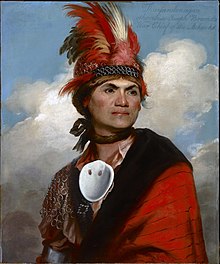
Back موهوك Arabic Mohawk ATJ موهاک AZB Магаўкі Byelorussian Магаўкі BE-X-OLD Мохок Bulgarian Mohawks Catalan Mohawkové Czech Mohawk Danish Mohawk German
This article may require cleanup to meet Wikipedia's quality standards. The specific problem is: Diacritics aren't in unicode, italicization and spellings are inconsistent, needs general copyediting. (August 2024) |
Kanienʼkehá꞉ka | |
|---|---|
 | |
| Regions with significant populations | |
| Canada (Quebec, Ontario) | 33,330[1] |
| United States (New York) | 5,632 |
| Languages | |
| English, Mohawk, French, Formerly: Dutch, Mohawk Dutch | |
| Religion | |
| Karihwiio, Kanohʼhonʼio, Kahniʼkwiʼio, Christianity, Longhouse, Handsome Lake, Other Indigenous Religion | |
| Related ethnic groups | |
| Seneca Nation of New York, Oneida Nation of Wisconsin, Cayuga Nation of New York, Onondaga Nation, Tuscarora Nation, other Iroquoian peoples | |

The Mohawk, or Kanien'kehá:ka (transl. "People of the flint";[2]) are an Indigenous people of North America and the easternmost nation of the Haudenosaunee, or Iroquois Confederacy.
Mohawk are an Iroquoian-speaking people with communities in southeastern Canada and northern New York State, primarily around Lake Ontario and the St. Lawrence River. As one of the five original members of the Iroquois League, the Mohawk are known as the Keepers of the Eastern Door who are the guardians of the Iroquois Confederation against invasions from the east.
Today, Mohawk people belong to the Mohawk Council of Akwesasne, Mohawks of the Bay of Quinte First Nation, Mohawks of Kahnawà:ke, Mohawks of Kanesatake, Six Nations of the Grand River, and Saint Regis Mohawk Tribe, a federally recognized tribe in the United States.[3]
At the time of European contact, Mohawk people were based in the valley of the Mohawk River in present-day upstate New York, west of the Hudson River. Their territory ranged north to the St. Lawrence River, southern Quebec and eastern Ontario; south to greater New Jersey and into Pennsylvania; eastward to the Green Mountains of Vermont; and westward to the border with the Iroquoian Oneida Nation's traditional homeland territory.
- ^ "Canada Census Profile 2021". Census Profile, 2021 Census. Statistics Canada Statistique Canada. 7 May 2021. Retrieved 3 January 2023.
- ^ "HAUDENOSAUNEE GUIDE FOR EDUCATORS" (PDF). National Museum of the American Indian. 2009. Retrieved 6 May 2024.
- ^ "Meet the People". National Museum of the American Indian. Retrieved 16 May 2024.
© MMXXIII Rich X Search. We shall prevail. All rights reserved. Rich X Search